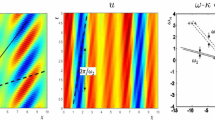Abstract
Based on a theoretical foundation for empirical mode decomposition, which dictates the correspondence between the analytical and empirical slow-flow analyses, we develop a time-domain nonlinear system identification (NSI) technique. This NSI method is based on multiscale dynamic partitions and direct analysis of measured time series, and makes no presumptions regarding the type and strength of the system nonlinearity. Hence, the method is expected to be applicable to broad classes of applications involving time-variant/time-invariant, linear/nonlinear, and smooth/non-smooth dynamical systems. The method leads to nonparametric reduced order models of simple form; i.e., in the form of coupled or uncoupled oscillators with time-varying or time-invariant coefficients forced by nonhomogeneous terms representing nonlinear modal interactions. Key to our method is a slow/fast partition of transient dynamics which leads to the identification of the basic fast frequencies of the dynamics, and the subsequent development of slow-flow models governing the essential dynamics of the system. We provide examples of application of the NSI method by analyzing strongly nonlinear modal interactions in two dynamical systems with essentially nonlinear attachments.
Similar content being viewed by others
References
Ewins DJ (1990) Modal testing: theory and practice. Research Studies Press, Baldock
Ibrahim SR, Mikulcik EC (1973) A time domain modal vibration test technique. Shock Vib Bull 43:21–37
Juang J-N, Pappa R (1985) An eigensystem realization algorithm for modal parameter identification and model reduction. J Guid Control Dyn 8(5):620–627
Van Overschee P, De Moor B (1995) A unifying theorem for three subspace system identification algorithms. Automatica 31(12):1853–1864
Kerschen G, Worden K, Vakakis AF, Golinval J-C (2006) Past, present and future of nonlinear system identification in structural dynamics. Mech Syst Signal Process 20(3):505–592
Silva W (2005) Identification of nonlinear aeroelastic systems based on the Volterra theory: Progress and opportunities. Nonlinear Dyn 39(1):25–62
Masri S, Caughey T (1979) A nonparametric identification technique for nonlinear dynamic systems. Trans ASME J Appl Mech 46:433–441
Leontaritis IJ, Billings SA (1985) Input-output parametric models for nonlinear systems. Part I. Deterministic nonlinear systems. Int J Control 41:303–328
Leontaritis IJ, Billings SA (1985) Input-output parametric models for nonlinear systems. Part II. Stochastic nonlinear systems. Int J Control 41:329–344
Feldman M (1994) Non-linear system vibration analysis using Hilbert transform—I. Free vibration analysis method ‘Freevib’. Mech Syst Signal Process 8(2):119–127
Feldman M (1994) Non-linear system vibration analysis using Hilbert transform—II. Forced vibration analysis method ‘Forcevib’. Mech Syst Signal Process 8(3):309–318
Thothadri M, Casas RA, Moon FC, D’Andrea R, Johnson CR (2003) Nonlinear system identification of multi-degree-of-freedom systems. Nonlinear Dyn 32(3):307–322
Masri S, Miller R, Saud A, Caughey T (1987) Identification of nonlinear vibrating structures. I. Formulation. Trans ASME J Appl Mech 54(4):918–922
Masri S, Miller R, Saud A, Caughey T (1987) Identification of nonlinear vibrating structures. II. Applications. Trans ASME J Appl Mech 54(4):923–950
Masri SF, Caffrey JP, Caughey TK, Smyth AW, Chassiakos AG (2005) A general data-based approach for developing reduced-order models of nonlinear MDOF systems. Nonlinear Dyn 39(1):95–112
Masri S, Tasbihgoo F, Caffrey J (2007) Development of data-based model-free representation of non-conservative dissipative systems. Int J Non-Linear Mech 42(1):99–117
Lee YS, Tsakirtzis S, Vakakis AF, Bergman LA, McFarland DM (2009) Physics-based foundation for empirical mode decomposition. AIAA J 47(12):2938–2963. doi:10.2514/1.43207
Manevitch LI (1999) Complex representation of dynamics of coupled nonlinear oscillators. In: Mathematical models of non-linear excitations, transfer, dynamics, and control in condensed systems and other media, pp 269–300
Manevitch LI (2001) The description of localized normal modes in a chain of nonlinear coupled oscillators using complex variables. Nonlinear Dyn 25:95–109
Vakakis AF, Gendelman O, Bergman LA, McFarland DM, Kerschen G, Lee YS (2008) Passive nonlinear targeted energy transfer in mechanical and structural systems: I and II. Springer, Berlin
Lochak P, Meunier C (1988) Multiphase averaging for classical systems: with applications to adiabatic theorems. Springer, Berlin
Huang N, Shen Z, Long S, Wu M, Shih H, Zheng Q, Yen N-C, Tung C, Liu H (1998) The empirical mode decomposition and the Hilbert spectrum for nonlinear and non-stationary time series analysis. Proc R Soc Lond, Ser A Math Phys Sci 454:903–995
Rilling G, Flandrin P, Gono̧alvès P (2003) On empirical mode decomposition and its algorithms. In: IEEE-Eurasip workshop on nonlinear signal and image processing, Grado, Italy
Sharpley RC, Vatchev V (2004) Analysis of the intrinsic mode functions. Industrial Mathematics Institute (IMI) Technical Reports, Department of Mathematics, University of South Carolina, No 12
Nayfeh A, Mook D (1979) Nonlinear oscillations. Wiley, New York
Bedrosian E (1963) A product theorem for Hilbert transform. Proc IEEE 51:868–869
Kerschen G, Lee YS, Vakakis AF, McFarland DM, Bergman LA (2006) Irreversible passive energy transfer in coupled oscillators with essential nonlinearity. SIAM J Appl Math 66(2):648–679
Lee YS, Vakakis AF, Bergman LA, McFarland DM, Kerschen G (2005) Triggering mechanisms of limit cycle oscillations due to aeroelastic instability. J Fluids Struct 21(5–7):485–529
Author information
Authors and Affiliations
Corresponding author
Additional information
This work was supported in part by the US Air Force Office of Scientific Research through Grant Number FA9550-07-1-0335.
Rights and permissions
About this article
Cite this article
Lee, Y.S., Tsakirtzis, S., Vakakis, A.F. et al. A time-domain nonlinear system identification method based on multiscale dynamic partitions. Meccanica 46, 625–649 (2011). https://doi.org/10.1007/s11012-010-9327-7
Received:
Accepted:
Published:
Issue Date:
DOI: https://doi.org/10.1007/s11012-010-9327-7




